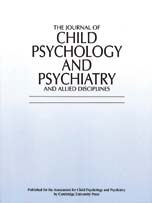Crossref Citations
This article has been cited by the following publications. This list is generated based on data provided by
Crossref.
Palumbo, Donna R.
and
Diehl, Joshua
2001.
Pediatric Neuropsychological Intervention.
p.
253.
Green, Dido
Baird, Gillian
Barnett, Anna L.
Henderson, Leslie
Huber, Jörg
and
Henderson, Sheila E.
2002.
The severity and nature of motor impairment in Asperger's syndrome: a comparison with Specific Developmental Disorder of Motor Function.
Journal of Child Psychology and Psychiatry,
Vol. 43,
Issue. 5,
p.
655.
Kroes, Mariëlle
Kessels, Alfons G H
Kalff, Ariane C
Feron, Frans J M
Vissers, Yvonne L J
Jolles, Jelle
and
Vles, Johan S H
2002.
Quality of movement as predictor of ADHD: results from a prospective population study in 5‐ and 6‐year‐old children.
Developmental Medicine & Child Neurology,
Vol. 44,
Issue. 11,
p.
753.
Kalff, Ariane C.
De Sonneville, Leo M.J.
Hurks, Petra P.M.
Hendriksen, Jos G.M.
Kroes, Marielle
Feron, Frans J.M.
Steyaert, Jean
Van Zeben, Thea M.C.B.
Vles, Johan S.H.
and
Jolles, Jelle
2003.
Low‐ and high‐level controlled processing in executive motor control tasks in 5–6‐year‐old children at risk of ADHD.
Journal of Child Psychology and Psychiatry,
Vol. 44,
Issue. 7,
p.
1049.
Gillberg, Christopher
2003.
ADHD and DAMP: A General Health Perspective.
Child and Adolescent Mental Health,
Vol. 8,
Issue. 3,
p.
106.
Chu, Sidney
2003.
Occupational Therapy for Children with Attention Deficit Hyperactivity Disorder: A Survey on the Level of Involvement and Training Needs of Therapists.
British Journal of Occupational Therapy,
Vol. 66,
Issue. 5,
p.
209.
Buitelaar, J.K.
Montgomery, S.A.
and
van Zwieten-Boot, B.J.
2003.
Attention deficit hyperactivity disorder: guidelines for investigating efficacy of pharmacological intervention.
European Neuropsychopharmacology,
Vol. 13,
Issue. 4,
p.
297.
Sonuga‐Barke, Edmund J. S.
2003.
On the Intersection Between AD/HD and DCD: The DAMP Hypothesis.
Child and Adolescent Mental Health,
Vol. 8,
Issue. 3,
p.
114.
PhD, Christina Kadesjö
Hägglöf, Bruno
and
Gillberg, Christopher
2003.
Attention‐deficit‐hyperactivity disorder with and without oppositional defiant disorder in 3‐ to 7‐year‐old children.
Developmental Medicine & Child Neurology,
Vol. 45,
Issue. 10,
p.
693.
Overtoom, C.C.E
Verbaten, M.N
Kemner, C
Kenemans, J.L
Engeland, H.van
Buitelaar, J.K
van der Molen, M.W
van der Gugten, J
Westenberg, H
Maes, R.A.A
and
Koelega, H.S
2003.
Effects of methylphenidate, desipramine, and l-dopa on attention and inhibition in children with Attention Deficit Hyperactivity Disorder.
Behavioural Brain Research,
Vol. 145,
Issue. 1-2,
p.
7.
Ramus, Franck
Pidgeon, Elizabeth
and
Frith, Uta
2003.
The relationship between motor control and phonology in dyslexic children.
Journal of Child Psychology and Psychiatry,
Vol. 44,
Issue. 5,
p.
712.
Dahlgren, Svenolof
Sandberg, Annika Dahlgren
and
Hjelmquist, Erland
2003.
The non-specificity of theory of mind deficits: Evidence from children with communicative disabilities.
European Journal of Cognitive Psychology,
Vol. 15,
Issue. 1,
p.
129.
Leibson, Cynthia L
and
Hall Long, Kirsten
2003.
Economic Implications of Attention-Deficit Hyperactivity Disorder for Healthcare Systems.
PharmacoEconomics,
Vol. 21,
Issue. 17,
p.
1239.
Chu, Sidney
2003.
Attention deficit hyperactivity disorder (ADHD) part one: a review of the literature.
British Journal of Therapy and Rehabilitation,
Vol. 10,
Issue. 5,
p.
218.
Barkley, Russell A
2003.
Issues in the diagnosis of attention-deficit/hyperactivity disorder in children.
Brain and Development,
Vol. 25,
Issue. 2,
p.
77.
Flapper, B. C. T.
Scholten-Jaegers, S.
and
Schoemaker, M. M.
2003.
Kinderen met een motorische coördinatiestoornis (dcd) in de kinderrevalidatie: motorische problematiek en comorbiditeit.
Tijdschrift voor kindergeneeskunde,
Vol. 71,
Issue. 5,
p.
79.
Cousins, Margaret
and
Smyth, Mary M
2003.
Developmental coordination impairments in adulthood.
Human Movement Science,
Vol. 22,
Issue. 4-5,
p.
433.
Visser, J.
2003.
Developmental coordination disorder: a review of research on subtypes and comorbidities.
Human Movement Science,
Vol. 22,
Issue. 4-5,
p.
479.
Barnhart, Robert C
Davenport, Mary Jo
Epps, Susan B
and
Nordquist, Vey M
2003.
Developmental Coordination Disorder.
Physical Therapy,
Vol. 83,
Issue. 8,
p.
722.
Tucha, Oliver
and
Lange, Klaus W.
2004.
Handwriting and Attention in Children and Adults with Attention Deficit Hyperactivity Disorder.
Motor Control,
Vol. 8,
Issue. 4,
p.
461.


